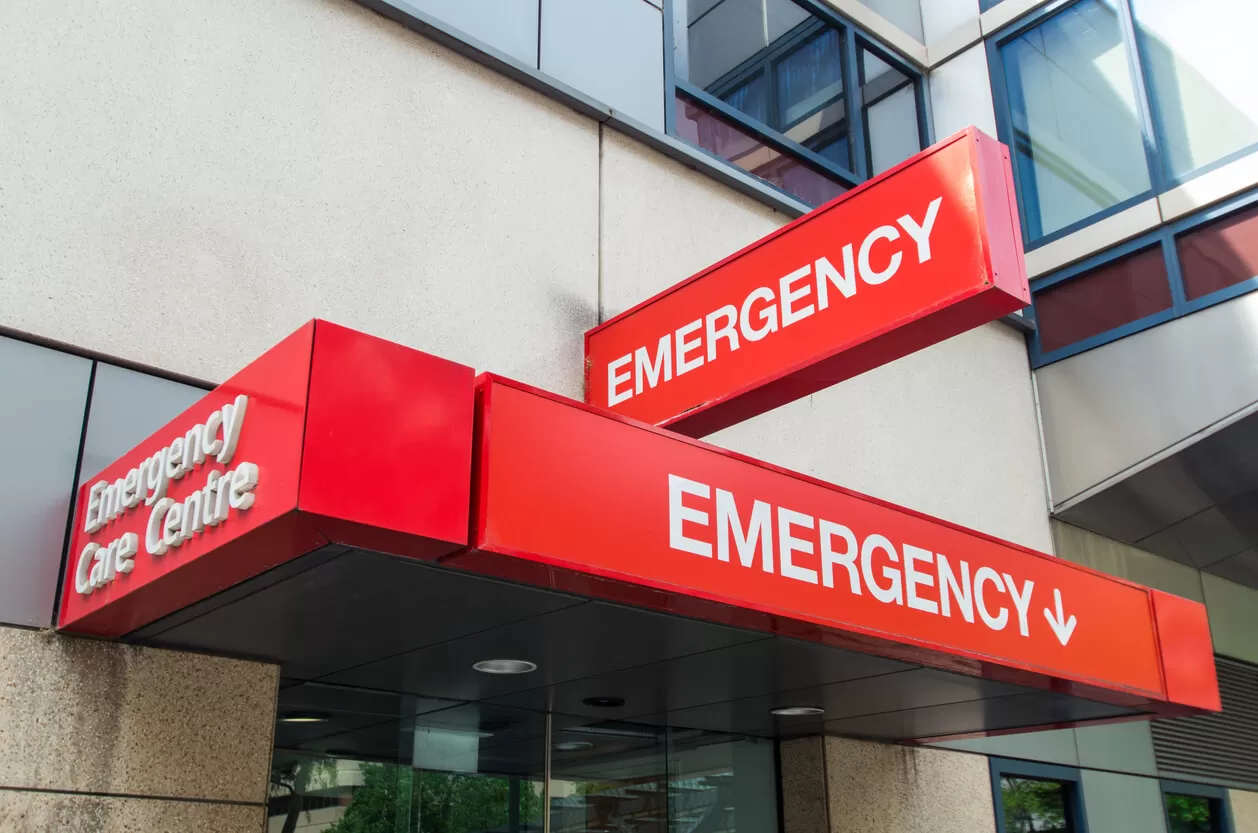Fever can be a signal from your body, indicating that something may be off. While many fevers are mild and manageable at home, there are times when it’s wise to seek medical help.
According to the National Center for Health Statistics, in 2022, fever was the fifth leading reason for emergency department visits in the United States, underscoring its consistent role as a significant symptom prompting individuals to seek medical attention. This article will help you understand when a fever for emergency room attention is necessary and how to manage a fever effectively.
What Is a Fever?
A fever happens when your body temperature rises above normal levels, usually as a natural response to fight off infections. Your average body temperature hovers around 98.6°F (37°C). When you have a fever, it means your body is trying to deal with something like a virus or bacteria. It’s a common symptom of various illnesses and can act as a warning sign that your immune system is at work.
A mild fever isn’t usually dangerous, but when it climbs too high, it’s important to pay attention and take appropriate action.
Common Causes of Fever
Fever often occurs when your body is battling something unusual. Recognizing the common causes can help you understand when to seek medical care:
- Viral Infections. Viruses, like those causing the flu or common cold, often lead to fever. These are very common illnesses where your body’s immune system ramps up to fight the invaders.
- Bacterial Infections. Some bacterial infections, including ear infections or urinary tract infections, can trigger a high body temperature. They often need medical treatment, such as antibiotics, for recovery.
- Heat Exhaustion. Spending too much time in the heat without proper hydration can result in heat exhaustion. This condition increases body temperature and can lead to heatstroke if not addressed.
- Inflammatory Conditions. Chronic diseases such as arthritis or inflammatory bowel disease can increase body heat. The inflammation they cause may spur the body’s defense mechanisms, including fever, as it tries to manage the inflammation.
- Reactions to Medications. Some medicines might cause fever as a side effect. If you suspect a drug-induced fever, look at the medication leaflet or consult a healthcare provider.
- Immunizations. Vaccines can sometimes cause a slight fever as the body builds protection against specific diseases. This response is usually temporary and mild.
- Teething in Infants. Teething can slightly raise body temperature in infants. This is generally not concerning, but monitoring is important to rule out other causes.
When to Treat Fever at Home
Many fevers are mild and can be safely managed in the comfort of your home. Here’s when it’s usually okay to handle a fever without rushing to urgent care:
- Low-Grade Fever. If the fever is just slightly above normal body temperature and there are no other severe symptoms, it might not require medical care. Keeping comfortable and hydrated is often enough.
- Short Duration. Fevers that last a day or two can often be managed at home, particularly if they respond well to over-the-counter medications like acetaminophen or ibuprofen.
- No Severe Symptoms. If there are no worrying symptoms like severe headache, difficulty breathing, or persistent vomiting, then home treatment is generally sufficient.
How to Treat Fever at Home
Treating a mild fever at home can be straightforward and effective. Here are some practical steps to help you or your loved ones feel better:
- Hydration. Drink plenty of fluids, especially water or herbal teas. Staying hydrated helps regulate body temperature and prevents dehydration, which is important when you have a fever.
- Rest and Recovery. Prioritize getting plenty of rest. Sleeping allows your body to fight off the infection more effectively and speeds up the recovery process.
- Over-the-Counter Medications. Taking medicines like acetaminophen or ibuprofen can help lower fever and relieve discomfort. Always follow the dosage instructions on the label or consult a healthcare provider if unsure.
- Comfort Measures. Stay comfortable by wearing light clothing, using a light blanket, or taking lukewarm sponge baths. These measures can help manage body heat and provide relief from discomfort.
When Should You Go to the Emergency Room for a Fever
A fever sometimes indicates more serious underlying issues that need immediate medical attention. Knowing when to head to the emergency care center can make all the difference. Here’s a detailed guide on when to seek emergency medical care for a fever:
For Babies
- Immediate Attention. If an infant under 3 months old develops a fever over 100.4°F (38°C), it’s essential to seek emergency care. This age group is more vulnerable, and high fever can be a sign of a serious infection.
- Signs of Distress. Be alert to unusual crying, changes in sleep patterns, difficulty breathing, or a persistent rash, as these symptoms warrant a trip to the ER.
- Poor Feeding. If a baby refuses to eat or has a noticeable decrease in wet diapers, consider it a red flag.
For Children
- Persistent or High Fever. If a child has a fever lasting more than three days or is associated with severe pain, like groin or abdominal pain, emergency care is advised.
- Severe Symptoms. Extreme tiredness, irritability, loss of appetite, dry mouth, or any signs of dehydration mean it’s time to visit the ER.
- Breathing Difficulties. Monitor for any trouble breathing or bluish lips, as these symptoms necessitate urgent medical evaluation.
For Adults
- Critical Symptoms. Fevers paired with symptoms like chest pain, severe headache, or difficulty breathing could indicate serious health conditions needing immediate assessment.
- Confusion or Fainting. Sudden confusion, fainting spells, or loss of consciousness alongside a fever are alarm bells for a medical emergency.
- Persistent Fever. If the fever doesn’t subside with treatment or exceeds 103°F (39.4°C), it’s wise to seek professional help.
For the Elderly
- Potential Complications. Older adults are more prone to complications, and even a slight fever may indicate underlying issues. Monitoring is key if existing medical conditions are present.
- Weakness and Falls. Any fever coupled with increased weakness, confusion, or falls requires prompt medical evaluation.
For Those with Existing Medical Conditions
- Chronic Health Considerations. People with chronic illnesses like diabetes or weakened immune systems should consider visiting the ER if they develop a fever, as it may exacerbate underlying health problems.
- New or Worsening Symptoms. New symptoms like muscle pain or fatigue in conjunction with fever can be concerning for those with chronic conditions.
Steps to Take Before Heading to the Emergency Room
These preparations facilitate a smooth transition to the emergency department:
- Document Symptoms and Interventions. Include a detailed list of the fever’s progression and any interventions taken.
- Secure Transportation. Choose safe and comfortable travel arrangements, particularly for vulnerable individuals.
- Organize Medical Details. Have identification, insurance, and healthcare documents ready for hospital staff.
How is a Fever Treated in the ER?
When a fever prompts a visit to the emergency room, the medical team acts quickly to address the cause and provide relief. Here are the steps typically involved in treating a fever in the ER:
Step 1: Initial Assessment
Upon arrival, healthcare professionals check vital signs, including temperature, heart rate, and blood pressure. They gather information about symptoms, duration of the fever, and any other health issues by reviewing the patient’s medical history.
Step 2: Physical Examination
Doctors perform a thorough physical examination to identify any visible signs of infection or distress. This helps pinpoint areas that may require further investigation.
Step 3: Diagnostic Testing
If necessary, blood tests, urine tests, or imaging such as X-rays or CT scans are ordered. These tests help identify underlying factors that could be causing the fever, like bacterial infections or other conditions.
Step 4: Administration of Medications
Depending on the diagnosis, medications like antipyretics (fever reducers), antibiotics (if a bacterial infection is suspected), or antivirals might be provided. Pain relievers may also be used to address body aches or discomfort.
Step 5: Intravenous Fluids
IV fluids are given to those showing signs of dehydration or requiring medications that need to be administered quickly. This helps restore hydration and allows for efficient medication distribution into the bloodstream.
Step 6: Monitoring Vital Signs
Continuous monitoring allows the medical team to track the patient’s response to treatment. This includes watching for changes in temperature and making sure the patient remains stable.
Step 7: Consultation with Specialists
If the fever is associated with more complex health conditions, specialists might be consulted to provide additional insights and recommendations.
Step 8: Admission if Needed
In cases where the fever is severe, or complications arise, the patient may be admitted to the hospital for further observation and treatment.
Step 9: Discharge and Follow-Up
Once the patient is stable and any immediate risks are addressed, they may be discharged with specific care instructions. Follow-up appointments with a primary care provider or specialist could be recommended to monitor recovery and prevent recurrence.
Make Your Health a Priority – Visit Reliant Emergency Today!
Recognizing when a fever calls for a trip to the emergency room is important for keeping your health in check. Acting quickly when symptoms become worrisome can lead to better care and a faster recovery.
At our emergency room, we’re ready to provide you with top-notch care when you need it most. If you’re facing a challenging fever situation, don’t hesitate to reach out. Our team is here 24/7 with the expertise and compassion you deserve. Trust us to support your health journey.







